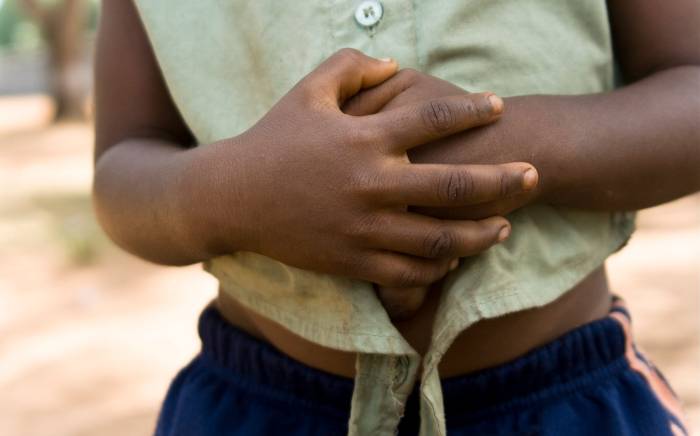What is sickle cell disease?
Sickle cell disease is an inherited blood disorder that is present at birth with symptoms becoming evident during the first year, often around 5 months. Children with sickle cell disease make an abnormal type of hemoglobin, the protein in red blood cells that carries oxygen to all parts of the body. With sickle cell disease, the body organs and tissues don’t get enough oxygen.
Healthy red blood cells with normal hemoglobin are round and move easily all over the body. When a child has sickle cell disease, the red blood cells are hard and sticky. They are shaped like the letter C (and like a farm tool called a sickle). These damaged red blood cells (sickle cells) can’t move easily through the blood vessels and clump together, blocking blood flow. This blockage can cause pain and damage to major organs.
Sickle cells die sooner than healthy cells. Normally the spleen helps filter infections out of the blood. But sickle cells get stuck in this filter and die. Having fewer healthy red blood cells causes anemia. The sickle cells can also damage the spleen. Without a healthy spleen, children are more at risk for serious infections.
Contact St. Louis Children's Hospital at 314.454.5437 or email us for more information about sickle cell disease and its causes.
What causes sickle cell disease?
Sickle cell disease is present at birth. It is inherited when a child has two sickle cell genes, one from each parent.
A child who has only one sickle cell gene is healthy. But he or she is a carrier of the disease. If two carriers have a child, there is a greater chance their child will have sickle cell disease.
Once parents have had a child with sickle cell disease, there is a 25% chance that another child will be born with sickle cell disease. There is also a 50% chance that a child will be a carrier, like the parents.
Having a family history of sickle cell disease increases a child’s risk for the disease. sickle cell disease mainly affects people whose families came from Africa, and Hispanics whose families are from the Caribbean. But the gene has also been found in people whose families are from the Middle East, India, Latin America, and Mediterranean countries. It has also been found in Native American Indians.
Symptoms of sickle cell disease
Most children with sickle cell disease will start to have symptoms during the first year of life, often around 5 months. Symptoms of sickle cell disease can include:
- Anemia. This is the most common symptom. Having fewer red blood cells causes anemia. Anemia can make a child pale and tired.
- Jaundice. Yellowing of the skin, eyes, and mouth. This is a common symptom of sickle cell disease. Sickle cells do not live as long as normal red blood cells. They die faster than the liver can filter them out. The yellow color is caused by a substance called bilirubin that is released when the red blood cells die.
- Pain crisis. When sickle cells move through small blood vessels, they can get stuck. This blocks blood flow and causes pain. This sudden pain can happen anywhere, but most often occurs in the chest, arms, and legs. Babies and young children may have painful finger and toe swelling. Blocked blood flow may also cause tissue death.
- Acute chest syndrome. This is when sickle cells stick together and block oxygen flow in the tiny vessels in the lungs. This can be deadly. It often occurs suddenly, when the body is under stress from infection, fever, or dehydration. It looks like pneumonia and can include fever, pain, and a violent cough.
- Splenic sequestration (pooling). The spleen becomes enlarged and painful when sickle cells get stuck and build up there. Fewer red blood cells are able to move. This can cause a sudden drop in hemoglobin. It can be deadly if not treated.
The symptoms of sickle cell disease may look like other disorders or health problems. Always see a healthcare provider for a diagnosis.
To schedule an appointment or to learn more about sickle cell disease, contact St. Louis Children's Hospital at 314.454.5437 or email us for more information.
Sickle cell disease diagnosis
Most states check newborn babies for abnormal hemoglobin as part of routine newborn screening tests. State newborn screening includes tests for all newborns within the first few days of life. These tests identify serious, life-threatening diseases.
Sickle cell disease may be found as part of newborn screening. Your family history, your child's medical history, and a physical exam are all included in the diagnosis. If the screening test shows sickle cell disease, a blood test called hemoglobin electrophoresis may be done. It can tell if your child is a carrier of sickle cell. It can also tell if your child has any of the diseases linked to the sickle cell gene. Other blood tests may also be done.
There are several complex types of the sickle cell gene. Some don’t cause symptoms or severe problems, but others do.
Contact St. Louis Children's Hospital at 314.454.5437 or email us for more information about the diagnosis of sickle cell disease.
Sickle cell disease treatment
The Sickle Cell Disease Program at St. Louis Children's Hospital focuses on providing disease-modifying therapy, treatment that modifies the course of the disease instead of only treating the symptoms of sickle cell, such as pain.
For example, the following disease-modifying therapies can potentially provide your child a better quality of life:
-
Hydroxyurea helps blood cells remain round and flexible. Studies have shown this medication decreases pain crises, acute chest syndrome, and the need for blood transfusions.
-
Chronic blood transfusion therapy is used to dilute the sickle hemoglobin (HbS) with normal hemoglobin to treat chronic pain, acute chest syndrome, and other emergencies.
-
Bone marrow or stem cell transplant can provide a cure for sickle cell disease. The procedure replaces abnormal blood cells with healthy stem cells from a donor, stopping the body’s production of diseased cells.
The Sickle Cell Disease Program team at St. Louis Children's Hospital includes pediatric hematologists, a child psychologist, nurse practitioners, nurse coordinators, a social worker, a child life specialist and a school liaison. The team works closely with you and your child to maintain good health and identify any potential complications early.
Contact St. Louis Children's Hospital at 314.454.5437 or email us for more information about sickle cell disease and its treatment.
Complications of sickle cell disease
Possible complications of sickle cell disease include:
- Long-term anemia. This may lead to delayed healing and delayed growth and development
- Pain crisis, or sickle crisis. In severe cases, treatment in a hospital may be needed.
- Acute chest syndrome. Over time, many episodes of acute chest syndrome can cause lasting (permanent) lung damage
- Splenic sequestration (pooling). When red blood cells build up in the spleen, it becomes enlarged and painful. The spleen can be damaged and scarred after many episodes of splenic sequestration. By age 8, many children with sickle cell disease have had their spleen removed. Or they may have lasting damage from repeated splenic sequestration. The risk of infection is a major concern for children without a working spleen. Infection is the major cause of death in children younger than age 5.
- Stroke. If the blood vessels to the brain are blocked, a stroke can occur. Serious long-term problems may result. A child who has had a stroke is more likely to have another one.
- Infections. Babies and children with sickle cell disease have a higher risk of infections.
- Priapism. The sickle cells block the blood vessels in the penis, causing great pain. If not treated right away, this can lead to the inability to have an erection (impotence).
Sickle cell disease can affect any major organ. This can cause:
- Frequent infections
- Leg ulcers or serious sores
- Bone damage
- Gallstones
- Kidney damage
- Eye damage
- Multiple organ failure
Contact St. Louis Children's Hospital at 314.454.5437 or email us for more information about sickle cell disease.
Living with sickle cell disease
Advances in preventive care and new medicines have reduced the life threatening problems of sickle cell. But it is still a severe, chronic, and sometimes fatal disease. Your child should be carefully managed by specialists. How your child is managed depends on the following:
- The type of sickle cell your child has
- How severe the disease is
- How often your child has complications
- How well you and your child follow preventive efforts
You may not be able to fully prevent your child from having complications of sickle cell disease, but helping your child live a healthy lifestyle can reduce some of the problems. Make sure your child has regular eye exams and gets stroke screening tests. Also talk with your child’s healthcare provider about making sure your child:
- Eats a healthy diet
- Gets enough sleep
- Drinks plenty of fluids
Avoid things that may trigger a crisis for your child. These include:
- High altitudes
- Cold weather
- Swimming in cold water
Help your child avoid infections by:
- Staying away from people who are sick
- Washing his or her hands often
- Having all recommended vaccinations (such as pneumococcal)
- Having all recommended screenings (such as hepatitis C)
Contact St. Louis Children's Hospital at 314.454.5437 or email us for more information about sickle cell disease.












